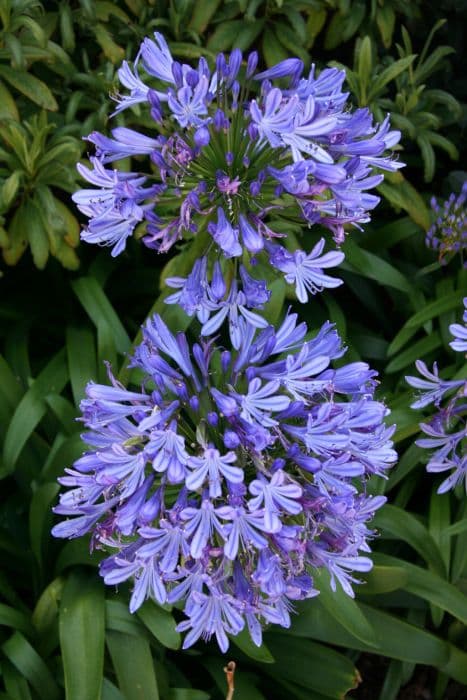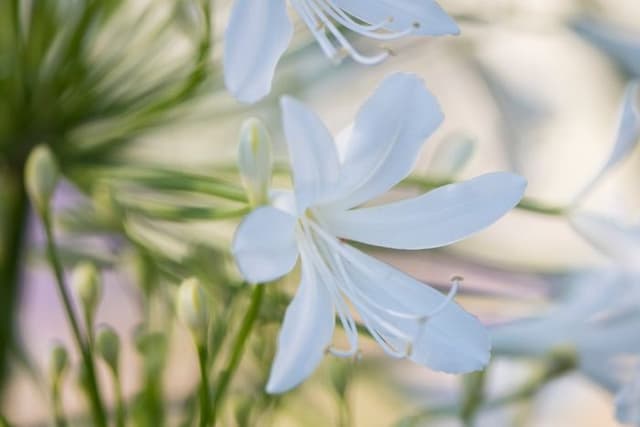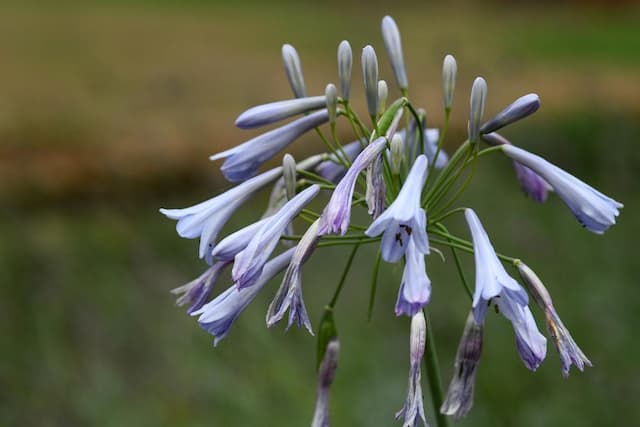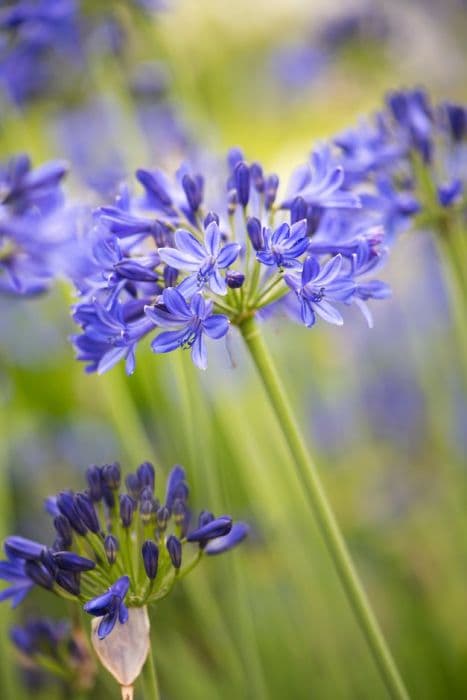African Lily Agapanthus 'Lavender Haze'

ABOUT
Agapanthus 'Lavender Haze' is a perennial plant known for its striking floral display. It has long, slender, arching leaves that create a lush, green backdrop for its standout feature – the flowers. The flowers of 'Lavender Haze' are borne on tall stems that rise above the foliage, each one ending in a large, rounded cluster of tiny, trumpet-shaped blooms. The flowers are a delicate lavender color, with a soft, ethereal quality that can add a touch of elegance to any garden space. These clusters, often referred to as umbels, create a haze of purple when viewed from a distance, contributing to the plant's descriptive name. The individual blossoms are neatly arranged around each spherical head, giving the inflorescences a very orderly and attractive appearance. Overall, Agapanthus 'Lavender Haze' is a graceful and charming plant that is particularly valued for the color and form of its spectacular summer blooms.
About this plant
 Names
NamesFamily
Amaryllidaceae
Synonyms
African Lily, Lily of the Nile, Love Flower
Common names
Agapanthus 'Lavender Haze'
 Toxicity
ToxicityTo humans
Agapanthus, commonly known as Lily of the Nile or African Lily, contains compounds that can be toxic if ingested. Consequently, poisoning can occur, primarily if a substantial amount of the plant is consumed. Symptoms of Agapanthus poisoning may include nausea, vomiting, abdominal pain, and diarrhea. In some cases, the skin can become irritated when coming into contact with the sap, causing dermatitis.
To pets
Lily of the Nile, or Agapanthus, is also toxic to pets such as dogs and cats. If pets ingest parts of the plant, they could experience symptoms of toxicity, which may include vomiting, diarrhea, abdominal pain, and lethargy. It is important to prevent pets from chewing on or consuming any part of this plant to avoid the potential for poisoning.
 Characteristics
CharacteristicsLife cycle
Perennials
Foliage type
Evergreen
Color of leaves
Green
Flower color
Lavender
Height
2 feet (60 cm)
Spread
2 feet (60 cm)
Plant type
Herb
Hardiness zones
8
Native area
South Africa
Benefits
 General Benefits
General Benefits- Attracts Pollinators: This variety of Agapanthus, also known as the African Lily, is known to attract beneficial pollinators such as bees and butterflies to the garden.
- Low Maintenance: African Lilies require minimal care once established, making them a convenient choice for gardeners of all skill levels.
- Drought Tolerance: They are relatively drought-tolerant, which is ideal for xeriscaping and water-wise gardening.
- Long Blooming Period: The 'Lavender Haze' variety offers a long flowering season, providing colors in the garden for an extended time.
- Visual Appeal: With its striking lavender-blue flowers, it adds aesthetic beauty and a pop of color to gardens, borders, and pots.
- Hardiness: African Lilies are known to be robust and can survive in a variety of climates and soil types.
 Medical Properties
Medical PropertiesThis plant is not used for medical purposes.
 Air-purifying Qualities
Air-purifying QualitiesThis plant is not specifically known for air purifying qualities.
 Other Uses
Other Uses- Agapanthus, commonly known as Lily of the Nile, can be used as a natural dye, where the flowers provide a range of hues from soft lavenders to deep purples.
- In crafting, the sturdy flower stalks of Lily of the Nile can be dried and used in floral arrangements or woven into decorative wreaths.
- The sap from Lily of the Nile's foliage can be used as a mild adhesive in small-scale or emergency repair situations.
- The mature seed heads of Lily of the Nile can be used artistically for printing patterns on fabric or paper by using them as stamps.
- Agapanthus leaves can be used in basketry, twisted or braided into strong cords or ropes due to their fibrous nature.
- The flowers of Lily of the Nile can be floated in large water bowls as a part of table centerpieces for outdoor events, adding color and elegance.
- The robust root system of Lily of the Nile can assist in soil stabilization, particularly on slopes where erosion is a concern.
- Agapanthus can be used in classrooms or educational programs as an example when teaching about pollination and the structure of flowers.
- Photographers and painters may use the blooms of Lily of the Nile as subjects for practicing and refining their depiction of color gradients and light.
- Culinary artists sometimes use the non-toxic blooms of Lily of the Nile as ornamental garnishes on plates and platters for special occasions.
Interesting Facts
 Feng Shui
Feng ShuiThe African Lily is not used in Feng Shui practice.
 Zodiac Sign Compitability
Zodiac Sign CompitabilityThe African Lily is not used in astrology practice.
 Plant Symbolism
Plant Symbolism- Love Letters: The name Agapanthus originates from the Greek words 'agape' meaning love, and 'anthos' meaning flower. 'Lavender Haze' alludes to a dreamy, romantic quality, suggesting that this plant symbolizes love and affection, often associated with the letters or messages exchanged between lovers.
- Beauty: With its striking lavender blooms, Agapanthus 'Lavender Haze' is often associated with beauty and a regal presence in a garden, making it a symbol of admiration for natural aesthetics.
- Fertility: Agapanthus, commonly known as African Lily, is known for its vigorous growth and abundant flowers. The lush blooms may symbolize fertility and abundance, reflective of the plant's own reproductive success.
- Endurance: This hardy perennial is known for its ability to withstand tough environmental conditions. Its resilience makes it a symbol of endurance and the ability to weather life's challenges.
- Freedom: The proliferation of African Lily's trumpet-shaped flowers reaching outwards on long stems can symbolize an expression of freedom or an escape from constraints.
 Water
WaterTo properly water African Lily 'Lavender Haze', allow the top inch of soil to dry out between waterings, typically once every week or two, depending on climate conditions. During the active growing season in spring and summer, you may need to water more frequently, providing about 1 to 2 gallons depending on the plant's size and the pot's diameter. In the dormant period of fall and winter, reduce watering to every two to three weeks to prevent root rot, ensuring you supply enough water to moisten the soil without waterlogging it.
 Light
LightAfrican Lily 'Lavender Haze' thrives best in full sun to partial shade. Ideally, place the plant where it can receive at least 6 hours of direct sunlight daily, but where it can also be protected from the scorching midday sun, particularly in hotter climates. An east- or west-facing garden spot is excellent for providing the right amount of natural light.
 Temperature
TemperatureThe African Lily 'Lavender Haze' prefers temperate conditions and can generally withstand temperatures between 50°F and 90°F. However, they grow best when daytime temperatures are around 70°F to 80°F. Protect the plant from temperatures below 50°F, as the African Lily is not frost-tolerant and can be damaged by extreme cold.
 Pruning
PruningPrune African Lily 'Lavender Haze' primarily to remove spent flower stalks and any damaged or dead foliage to encourage new growth and maintain a tidy appearance. The best time for pruning is after flowering has ceased or in early spring before new growth begins. Prune once a year or as necessary to keep the plant healthy and well-shaped.
 Cleaning
CleaningAs needed
 Soil
SoilFor African Lily 'Lavender Haze', a well-draining soil mix is best. Combine two parts loam, one part perlite or pumice, and one part organic compost to foster good drainage and fertility. The ideal soil pH for this plant is between 6.0 and 7.0 to keep it healthy and blooming.
 Repotting
RepottingAfrican Lily 'Lavender Haze' should be repotted every 2 to 3 years, or when it becomes root-bound. It's important to increase the pot size gradually, as they bloom better when slightly root-bound.
 Humidity & Misting
Humidity & MistingAfrican Lily 'Lavender Haze' thrives in moderate humidity conditions. Average room humidity is generally sufficient; however, they enjoy a slight increase in humidity and perform well when outdoor humidity levels mimic their native environment.
 Suitable locations
Suitable locationsIndoor
Place in bright light with some direct sun and follow regular watering.
Outdoor
Plant in sun or partial shade, ensure well-draining soil.
Hardiness zone
8-11 USDA
 Life cycle
Life cycleAgapanthus 'Lavender Haze', commonly known as the African Lily, begins its life as a seed which, upon germination in appropriate conditions of warmth and moisture, develops into a young seedling. The seedling then establishes a root system and grows into a vegetative stage characterized by strap-like leaves. As the plant matures, it enters a phase of reproductive maturity, typically signaled by the emergence of tall stalks topped with rounded clusters of lavender-colored flowers during the summer. After the flowering period, seed pods may form, which eventually dry and release seeds for the next generation, completing the reproductive cycle. During colder months, the African Lily may die back, especially in cooler climates, but its rhizomatous roots enable it to survive and regrow in the following growing season. Perennial in nature, this plant will continue this cycle for many years, with proper care and favorable conditions.
 Propogation
PropogationPropogation time
Spring-Summer
The Agapanthus 'Lavender Haze', commonly known as the African Lily, can be propagated by dividing its clumps. The best time to propagate this plant is in spring, just before the growing season begins. To propagate by division, carefully lift the clump from the ground using a shovel. Once out of the ground, use a sharp knife or spade to divide the root mass into smaller sections, ensuring that each section has at least one or two growing points or shoots. Replant these divisions immediately in well-draining soil, spacing them about 18 inches (45 centimeters) apart to allow enough room for growth. Water the new plants thoroughly to help establish their roots in the new location. Division is the most popular method for this plant, as it is straightforward, does not harm the parent plant, and supports vigorous growth in the new plants.









